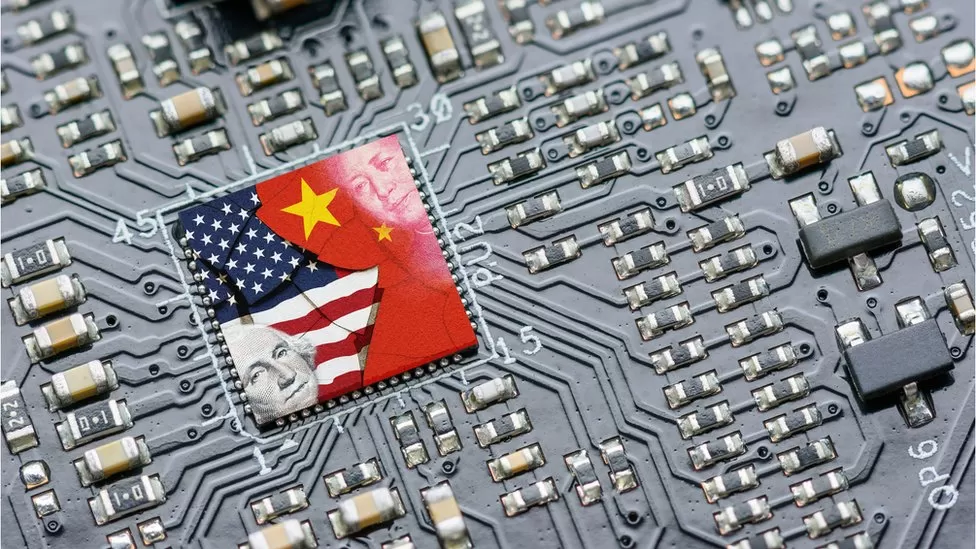Digital Zeitgeist – Chip Wars: Navigating the US-China Semiconductor Struggle in a Global Tech Revolution
With the relentless march of technological advancement shaping global geopolitics, the realm of semiconductors has rapidly emerged as a highly contentious arena in the relationship between the United States and China. Not merely a component of smartphones, computers, or modern appliances, semiconductors represent the lifeblood of emerging technologies, from artificial intelligence and quantum computing to autonomous weaponry. As US Treasury Secretary Janet Yellen journeys to Beijing in an endeavour to fortify economic ties, the escalating chip war between the two superpowers looms large on the agenda.
These semiconductor skirmishes signal the struggle for technological supremacy in the 21st century, the bone of contention being China’s ambition to become self-reliant in the production of advanced microchips. A recent pronouncement from Beijing elucidates this stance; the Global Times, a Chinese state media tabloid, proclaimed, “There’s no reason for China to continue exhausting its own mineral resources, only to be blocked from pursuing technological development…”. This came alongside export restrictions imposed by China on two minerals essential to the production of semiconductors and advanced technology, setting an inauspicious tone for Yellen’s diplomatic venture.
Meanwhile, Washington is reportedly preparing to amplify its own restrictions on the sale of advanced microchips to China. The motivation behind the United States’ actions is twofold. First, there are concerns that China’s People’s Liberation Army (PLA) could outstrip the US military’s power. Second, there is trepidation that China could leverage American technology to achieve this end. President Xi Jinping’s mandate to the PLA to become a “world-class” military by 2049, involving the development of autonomous weaponry and extensive application of AI, has raised alarms in the Pentagon. The US Department of Defense, in its annual report on China’s military power, highlights the PLA’s pursuit of next-generation combat capabilities defined by advanced technologies and AI.
China, while a global leader in specific AI applications, such as facial recognition, lacks domestic proficiency in producing the most advanced semiconductors. Consequently, Chinese businesses and the military are heavily reliant on imports of high-end chips. Hence, the US strategy focuses on severing this supply line.
In October last year, the Biden administration imposed sweeping export controls to limit China’s access to US-origin semiconductors and related products. The restrictions necessitate a specific licence from the US government for Chinese entities to purchase advanced chips and chipmaking technology from US suppliers. This was further reinforced in January, with the United States persuading Japan and the Netherlands to curtail exports of advanced chip manufacturing technologies.
The fallout from these measures has been significant. Jensen Huang, CEO of Nvidia, a leading chip company, warns that these restrictions could inflict “enormous damage” on the tech industry. Nvidia’s revenues from China and Hong Kong plummeted by nearly 20% year-on-year in the 12 months to February. Additionally, Chinese companies are feeling the squeeze; chip imports were down almost 30% in the first five months of this year compared with the same period in 2022, according to China’s General Administration of Customs.
China’s reaction has been predictably adverse. People’s Daily, the official newspaper of the CCP, accused the US of “containment and suppression”. In retaliation, Beijing banned chips made by US company Micron from being used in critical infrastructure projects.
Yet, Chinese businesses persist in their attempts to procure top-end chips, circumventing export controls through creative means such as renting chips or purchasing them via intermediaries. As a result, a burgeoning black market for smuggled semiconductors is emerging. The US and Dutch governments are now considering broadening their restrictions, including a clampdown on Nvidia’s A800 chips and the leasing of cloud services that some firms have used to evade the rules.
Despite claims of working towards diplomatic rapprochement, the two superpowers appear to be diverging further when it comes to this crucial technology. It seems the stage is set for the next phase of this technological tussle; and as the protagonists of this new-age Cold War sharpen their strategies, the global technology landscape is poised to change irreversibly.
Concluding Thoughts: A Devil’s Advocate Perspective
However, it is essential to take a step back and reflect upon the larger consequences of this US-China chip warfare. While the instinct to protect national security interests is understandable, the ramifications of this strategic tug-of-war extend far beyond the two nations.
The growing fragmentation of the global technology ecosystem could stifle innovation and impede economic growth. As stated by Jensen Huang of Nvidia, the restrictions risk causing “enormous damage” to the tech industry. Forcing nations to ‘pick sides’ could lead to inefficient allocation of resources and impede technological advancements on a global scale. Furthermore, such measures may also spur a race towards complete self-reliance in critical technologies, prompting nations to reinvent the wheel instead of benefiting from global synergies.
In addition, it is pertinent to consider whether the measures taken by the US will effectively address its stated concerns. As China has demonstrated, it is both motivated and capable of finding ways around restrictions. Therefore, rather than containing China’s technological ambitions, the US may inadvertently be stimulating them.
Moreover, while the current flashpoint centres on China and the US, the underlying narrative of technological supremacy is far more global. Technological prowess is not exclusive; many other countries and companies worldwide contribute significantly to advancements in AI, autonomous weaponry, and, of course, semiconductors.
Ultimately, fostering collaborative global strategies and strengthening international regulations may prove more fruitful in managing the technological tussles of the 21st century. After all, the aspiration for a ‘world-class’ technological landscape should ideally transcend national boundaries.
Disclaimer: The views and opinions expressed in this article are those of the author and do not necessarily reflect the official policy or position of GPM-Invest or any other organisations mentioned. The information provided is based on contemporary sourced digital content and does not constitute financial or investment advice. Readers are encouraged to conduct further research and analysis before making any investment decisions.

